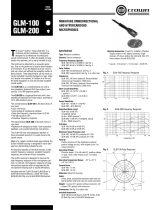
2
Introduction
Thank you for choosing Genelec! Fulfilling your dreams by
offering the most truthful sound reproduction has been the
source of our enthusiasm since 1978. Already over one million
Genelec monitors are in use around the world - welcome to our
story!
Genelec monitors are designed to last long our spare
part support extends far into future. They are hand-built in
Iisalmi, Finland, using certified sustainable methods. They are
individually tested and calibrated for the highest performance.
They have also all been designed for low power consumption in
use and in standby.
Please register your monitor at
http://www.community. genelec.com/
and receive an extended five-year warranty for spare parts.
For more information about our service and technical support,
please visit
http://www.genelec.com/customer-service.
System Characteristics
Each 8351B is supplied with a mains power cable, five-meter
GLM network cable and this operating manual. The Genelec
8351B is suitable for all professional monitoring applications
calling for very high precision and reliability. The 8351B
combines many remarkable Genelec technologies to provide
the benefits of a point source and controlled directivity over
an extraordinarily wide audio bandwidth. The 8351B may be
oriented horizontally or vertically. Listening distances can vary
from less than one meter to more than 4 meters, depending on
the room size and maximum sound level requirements.
Genelec Loudspeaker Manager™ (GLM™)
Software and GLM User Kit
The GLM software tailor-fits the 8351B to your room. It is
downloadable free of charge at www.genelec.com/glm. Check
regularly for updates and new features, and consider using the
cloud-based GLM services for the most up-to-date methods.
A GLM User Kit, comprising a USB adapter device and
measurement microphone, enables precise acoustic calibration
and operation of the GLM loudspeaker management network.
Minimum Diffraction Coaxial (MDC™)
The minimum diffraction coaxial transducer MDC design
implements a coaxial driver with unparalleled acoustic directivity
control. A powerful midrange transducer surrounds a high
output tweeter transducer, enabling a high resolution response
extending to ultrasonic frequencies. The MDC minimizes
acoustic diffraction, produces a flat frequency response on the
acoustical axis, and a neutral off-axis sound character.
Directivity Control Waveguide (DCW™) and
Acoustically Concealed Woofers (ACW™)
The 8351B has an exceptionally large Directivity Control
Waveguide extending over the whole enclosure front. The
midrange transducer cone forms a part of this DCW. Two woofers
radiate low frequencies through openings at the enclosure edges
and sum acoustically placing bass on the same acoustical axis
with the coaxial transducer. This unique design enables directivity
control of all audio down to low bass frequencies.
Smart Active Monitoring (SAM™)
Smart Active Monitors automatically tune several parametric
filters in themselves to precisely compensate for room
colorations using Genelec Loudspeaker Manager (GLM)
software. This enables SAM monitors to sound neutral and
achieve precise stereo imaging in all acoustical environments,
improving accuracy of monitoring.
Audio Inputs
The 8351B inputs support balanced analog line-level audio and
AES/EBU digital audio. At maximum sensitivity, -6 dBu analog
and -30 dBFS digital audio signals produce 100 dB SPL level at
one meter distance in free space.
The analog input is selected when a digital signal is not
present. The digital input is selected automatically when a
digital signal is present even when the signal is silent. The GLM
software can select either input.
When the digital audio source can adjust level, it is
advantageous to lower the output level of the 8351B using the
rear panel controls or the GLM Master Fader. This enables a
higher output level at the source with more resolution while
taking full advantage of the impressively low self-generated
noise of the 8351B.
An AES/EBU digital audio signal carries two channels in one
cable. A channel is selected using the DIP switches or GLM
software. The DIGITAL OUT carries an unaltered copy of the
input, enabling daisy-chaining of up to four monitors.
Power Management
The mains power input supports any mains voltage (100-240
VAC, 50-60 Hz) and the 8351B always delivers full power even
when the mains voltage fluctuates. When powered with a
generator, inverter or UPS device, we recommend filtering the
mains power to remove harmonics.
The energy saving function Intelligent Signal Sensing (ISS™)
puts the monitor to power educed sleep mode when no signal
is present. Upon sensing an input, the monitor wakes up. The
function is activated using GLM software or the ISS dip switch
on the monitor. With GLM the time before entering the sleep
mode can be adjusted, the ISS dip switch activates a fixed 60
minute time.
Setup Using The GLM™ Control
Genelec recommends setting up the 8351B and other SAM
monitors using GLM. This is described in the GLM System
Operating Manual. Although it can be used without GLM and the
network, the 8351B reaches its full potential with this method.
GLM software runs on Mac or Windows computers. GLM also
works as a monitor controller, for switching between sets of
loudspeakers, soloing, muting, invoking calibrated levels, etc.
Setup with the GLM User Kit consists of the following steps:
1. Connect a CAT5 (RJ45) cable to each monitor (and
subwoofer) and finally to the GLM Adapter device (see
Figure 1).
2. Connect the GLM Adapter device to computer USB connector.
3. Using a microphone stand, place the Genelec measurement
microphone (in GLM Kit) at the listening location. Point
microphone upwards. Place the microphone top at the ear








